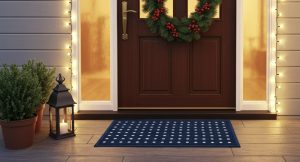Moving out can be a whirlwind of packing boxes and signing papers. Amid the chaos, the final end of tenancy cleaning is often rushed or overlooked. This can be a costly mistake, leading to disputes with your landlord and deductions from your security deposit. But don’t worry! With a solid plan and a good cleaning checklist, you can leave your rental sparkling and ensure a smooth end to your tenancy. This guide will walk you through the most common cleaning errors and how to avoid them.
Table of Contents
Toggle10 End of Tenancy Cleaning Mistakes Tenants Make and How to Avoid Them
Are you confident your cleaning will pass the final inspection? To help you secure your deposit and leave on good terms at the end of the tenancy, we’ve identified the top 10 end of tenancy cleaning mistakes. The following sections will provide actionable tips and a clear cleaning checklist so you can tackle your move-out clean like a pro:
1. Overlooking Hidden Spots and Hard-to-Reach Areas
One of the quickest ways to fail an end of tenancy inspection is by only cleaning what’s at eye level. Landlords and property managers are trained to look in the places most people forget. Dust and grime accumulate in spots you don’t normally see, and leaving them untouched gives the impression of a lazy cleaning job.
To make sure your rental passes the final inspection, you need to be meticulous. Your cleaning checklist should include those out-of-sight areas that collect dust and dirt over time. Think like an inspector: get on a step stool and look on top of cabinets, and get on your knees to check under furniture. A thorough job shows you’ve respected the property throughout your tenancy.
Pay special attention to these commonly missed spots:
- The tops of wardrobes, doorframes, and kitchen cabinets.
- Behind large appliances and furniture.
- Light fixtures, ceiling fans, and inside light switches.
2. Ignoring Appliance Cleaning (Oven, Refrigerator, Washer)
Appliances are workhorses in any home, and they show it. A greasy oven, a stained refrigerator, or a moldy washing machine seal are major red flags during an end of tenancy walkthrough. Many tenants give these appliances a quick wipe-down, but they require a deep clean to be returned to their original state. This means removing all traces of food, grease, and limescale.
Wondering if your landlord can charge you for cleaning? In many places, yes. For instance, according to the California Courts Self-Help Guide, a landlord can deduct from a security deposit the cost of cleaning the unit to the same level of cleanliness it was at the start of the tenancy. This makes deep cleaning your appliances essential.
To get your appliances inspection-ready, be sure to:
- Thoroughly degrease the oven and hob, cleaning racks and trays separately.
- Empty and clean the refrigerator and freezer, not forgetting the rubber door seals.
- Clean the microwave, dishwasher filter, and washing machine drawer.
3. Failing to Remove Stains from Carpets and Upholstery
Carpets and upholstery can make or break an inspection. A single prominent stain can lead to a significant deduction from your deposit. While “fair wear and tear” is expected, noticeable stains from spills, pets, or burns are considered damage and are the tenant’s responsibility. Leaving these for the landlord to handle is a gamble you don’t want to take.
Here’s how to address carpets and upholstery:
- Vacuum thoroughly, moving all furniture to clean the entire area.
- Address any new stains immediately, as they are easier to remove when fresh.
- Consider a professional steam clean for a guaranteed deep clean, especially for high-traffic areas.
4. Forgetting to Clean Walls, Doors, and Ceilings
Walls, doors, and ceilings are often overlooked, but they are part of the overall impression of cleanliness. Scuff marks from furniture, fingerprints around light switches, and cobwebs in the corners can make an otherwise clean room look neglected. Your landlord has the right to expect these surfaces to be as clean as when you moved in.
Don’t forget to add these items to your cleaning checklist:
- Gently wipe down walls to remove scuff marks and smudges.
- Clean door surfaces, handles, and the often-missed tops of doorframes.
- Use a long-handled duster to clear cobwebs from ceilings and corners.
5. Skipping Bathroom Deep Cleaning (Tiles, Grout, Fixtures)
A sparkling bathroom is a must for any end of tenancy cleaning. This room is scrutinized for hygiene, and any sign of mold, limescale, or soap scum will be noted immediately. A quick wipe of the sink and toilet isn’t enough; a deep clean is essential to pass the inspection and demonstrate that you’ve maintained the property well.
Your bathroom deep clean should include:
- Scrubbing tiles and grout to remove mold and mildew. An old toothbrush works wonders.
- Descaling the showerhead, taps, and other fixtures to make them shine.
- Cleaning the toilet thoroughly (inside and out), as well as the bathtub, shower, and sink.
6. Neglecting Windows and Window Treatments
Clean windows can dramatically brighten a room and make the entire property feel cleaner. However, tenants often forget to clean the glass, frames, sills, and window treatments like blinds or curtains. Streaky, dusty windows and dirty blinds are an easy catch for a landlord during the final walkthrough.
Make sure your windows are picture-perfect by:
- Wiping down window frames and sills to remove dust and grime.
- Cleaning the inside of all glass for a streak-free finish.
- Dusting blinds slat by slat and checking curtains for any new stains.
7. Leaving Behind Trash and Personal Belongings
It may seem obvious, but one of the most common mistakes tenants make is leaving behind personal items or trash. After days of packing, it’s easy to forget a few things in a cupboard or leave a full trash can behind. However, your landlord will have to pay someone to remove these items, and that cost will be passed directly on to you.
Before you leave for the final time, be sure to:
- Remove all trash and food waste from the property.
- Empty and disinfect all indoor and outdoor bins.
- Do a final sweep of all rooms, cupboards, and storage areas to ensure nothing is left behind.
8. Not Checking Outdoor Spaces (Patios, Balconies, Entryways)
The entryway—not the living room—creates your rental’s first impression. Outdoor spaces like balconies, patios, and steps are often overlooked but must be cleaned too. Leaves, weeds, and dirt can make your property look messy before anyone even enters. Set aside time for these areas; cleaning them may add an hour or more to your end-of-tenancy process, but it’s worth it for a smooth handover.
Outdoor Cleaning Checklist:
- Patios/Balconies: Sweep leaves and debris; power wash if needed.
- Entryways: Clean the front door, sweep steps, remove cobwebs.
- Yard/Garden: Mow lawn, pull weeds, tidy flower beds.
- Bins: Empty and wipe outdoor bins.
9. Using the Wrong Cleaning Products or Methods
Grabbing the strongest cleaner may seem effective, but using the wrong products or abrasive tools can cause costly damage—like scratching stainless steel, stripping paint, or discoloring countertops. Repairs are far pricier than cleaning and may come out of your deposit.
To prevent mistakes:
- Read product labels to ensure surface compatibility.
- Use non-abrasive cloths on delicate surfaces.
- Avoid bleach or harsh chemicals on colored grout or natural stone.
10. Rushing the Cleaning Process and Missing Details
The biggest mistake tenants make is underestimating the time needed for a proper end of tenancy clean. Many leave it until the last day and end up rushing, missing important details that landlords will notice. For a standard three-bedroom house, a thorough clean takes several hours and shouldn’t be done in just one afternoon. Start cleaning at least two to three days before your move-out date. Use a detailed checklist, mark off tasks as you complete them, and do a final walkthrough from your landlord’s perspective to ensure nothing is missed.
Secure Your Deposit and Peace of Mind — Book End of Tenancy Cleaning Today!
Feeling overwhelmed by your end of tenancy cleaning checklist? You’re not alone. Balancing packing, moving, and deep cleaning is a stressful experience. This raises the question: is it better to hire a professional service or do the cleaning yourself? While DIY can save money, it offers no guarantee. A professional cleaning service like Cleenora Maids ensures every item on your landlord’s list is checked off, securing your deposit and saving you valuable time.
The cost of end of tenancy cleaning is a worthwhile investment for your peace of mind. When you consider the risk of losing a much larger security deposit, hiring professionals is a smart financial decision. Let our experienced team handle the hard work, so you can focus on settling into your new home.
Conclusion
In summary, avoiding common end of tenancy cleaning mistakes is crucial to ensuring you secure your deposit and leave a positive impression on your landlord. From overlooking hidden spots to not using the right cleaning products, each mistake can cost you dearly. By paying attention to details and thoroughly addressing each area of your rental, you can mitigate risks and enhance your chances of a successful inspection. Remember, a little extra effort in cleaning can save you from financial setbacks and headaches later.
Want to make your move even easier? Don’t miss our guide on Smooth Move-Out Cleaning Tips for a Stress-Free Transition — packed with practical advice to help you leave your rental spotless and stress-free.
Frequently Asked Questions
How do I make sure my rental passes the end of tenancy cleaning inspection?
To ensure you pass, use your original move-in inventory as a guide and follow a comprehensive cleaning checklist. Clean every room thoroughly, paying extra attention to kitchens, bathrooms, and hidden spots. For guaranteed results that satisfy your landlord, consider hiring professional end of tenancy cleaning services.
How much does end of tenancy cleaning usually cost?
The cost varies depending on the size and condition of your property. On average, you can expect to pay between $225 and $300 for a three-bedroom house. While this is an upfront cost, it’s often less than the amount a landlord might deduct from your deposit for an inadequate cleaning job.
How long does end of tenancy cleaning typically take?
End of tenancy cleaning duration depends on property size, condition, and number of cleaners. A standard three-bedroom house usually takes 3 to 8 hours. DIY cleaning may require a full day, while professionals often finish faster and deliver better results.
Is it better to hire a professional service or do end of tenancy cleaning myself?
Doing it yourself is cheaper but requires significant time and effort, with no guarantee of meeting your landlord’s standards. Hiring professional cleaning services costs more but provides expertise, efficiency, and peace of mind, greatly increasing your chances of getting your full security deposit back without any disputes.







